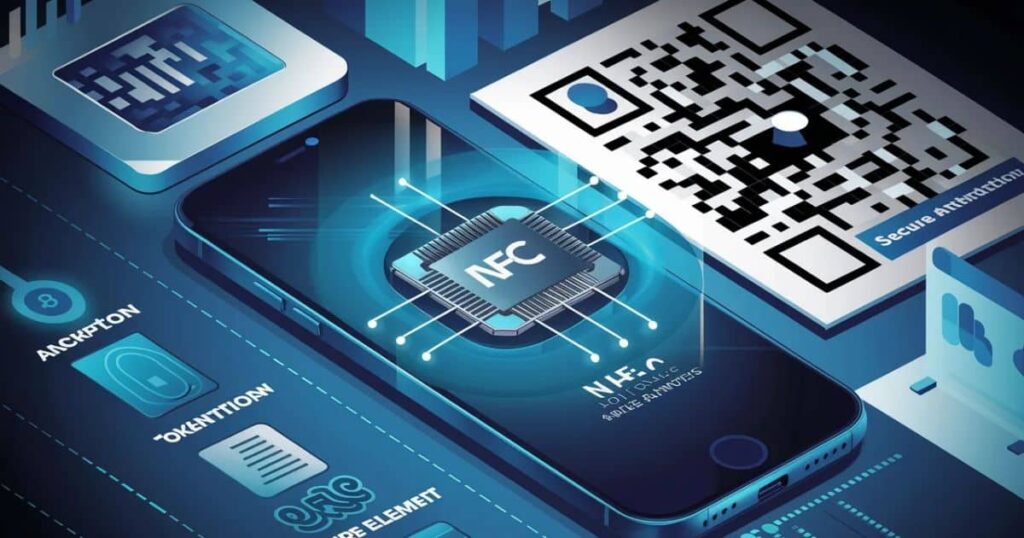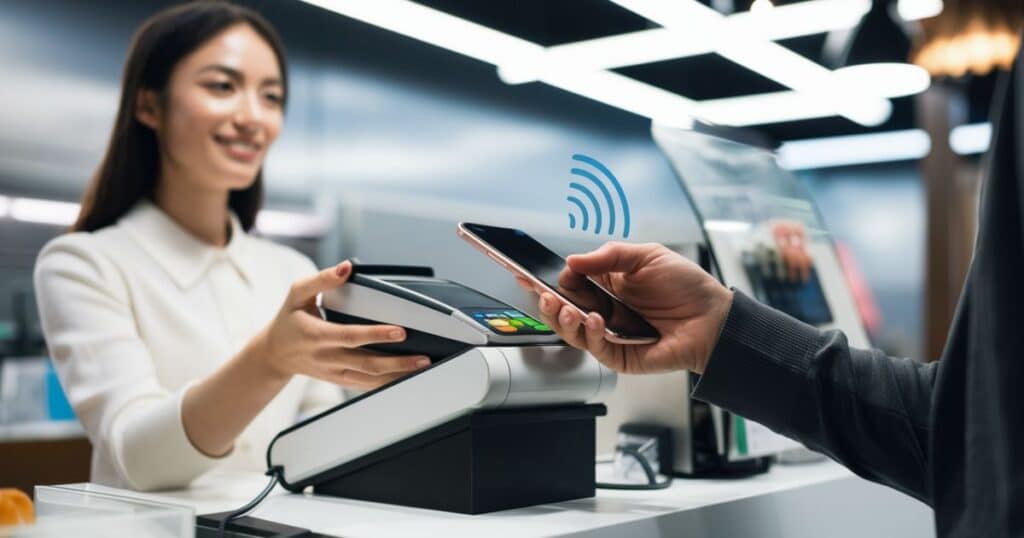In today’s fast-paced world, convenience and security are paramount when it comes to financial transactions. Imagine being able to make secure payments with just a tap of your smartphone, without the need for physical cards or cash.
This is the reality that Near Field Communication (NFC) mobile payments have brought to the forefront. NFC technology is revolutionizing the way we make payments, offering a seamless and secure experience that is quickly becoming the norm.
Understanding NFC Mobile Payments
NFC mobile payments are a form of contactless payment method where a mobile wallet or an NFC-enabled credit or debit card wirelessly communicates with a payment terminal to send encrypted payment information from the customer to the retailer. This technology leverages the power of NFC, which allows two devices in close proximity (usually within a few inches) to establish a radio communication and exchange data.
Some popular NFC-enabled mobile wallets include:
- Apple Pay
- Google Pay
- Samsung Pay
These digital wallets allow users to store their credit or debit card information securely on their smartphones and make payments with a simple tap or hover over an NFC-enabled payment terminal.
The Working Mechanism of NFC Mobile Payments
The process of making an NFC mobile payment is relatively straightforward, yet highly secure. Here’s a step-by-step breakdown:
Initiating the Payment
The customer initiates the payment process by launching their preferred mobile wallet app and selecting the desired payment method (e.g., credit card, debit card, or other stored payment options). This step may also involve biometric authentication, such as fingerprint or facial recognition, for added security.
Data Transmission and Encryption
When the customer holds their NFC-enabled device near the payment terminal, the two devices establish a secure connection using NFC technology. The mobile device transmits the encrypted payment information to the terminal, ensuring that sensitive data remains protected during the transaction.
Authentication and Authorization
The payment terminal receives the encrypted data and sends it to the appropriate payment processor for authentication and authorization. This process typically involves verifying the customer’s available funds, validating the payment method, and checking for any potential fraud or security concerns.
Transaction Completion
If the transaction is approved, the payment terminal receives confirmation and displays a successful payment message. The customer may also receive a notification on their mobile device, confirming the completion of the transaction.
Security Aspects of NFC Mobile Payments

One of the primary advantages of NFC mobile payments is the enhanced security they offer compared to traditional payment methods. Here are some key security features:
Encryption and Tokenization
NFC mobile payments employ advanced encryption techniques to secure the transmission of payment data between the mobile device and the payment terminal. Additionally, tokenization is often used, where the actual card details are replaced with a unique token or code, making it useless for potential hackers even if the data is intercepted.
Biometric Authentication
Many mobile wallets and payment apps require biometric authentication, such as fingerprint or facial recognition, before allowing access to the payment functionality. This added layer of security ensures that only authorized users can initiate transactions, preventing unauthorized access and fraud.
One-Time Codes
NFC mobile payments often generate and use one-time codes or tokens for each transaction. These codes are unique and cannot be reused, minimizing the risk of data breaches or unauthorized access to sensitive payment information.
Addressing Security Concerns
Despite the robust security measures in place, some consumers may still have concerns about the safety of NFC mobile payments. To address these concerns, businesses and payment providers can:
- Educate customers about the encryption, tokenization, and authentication processes involved in NFC payments.
- Highlight the advantages of NFC payments over traditional payment methods in terms of security and fraud prevention.
- Provide clear guidelines and best practices for secure NFC payment usage.
- Regularly update their security protocols and technologies to stay ahead of potential threats.
Read More: What Is The Quick Card San Diego Charge on Your Bank Statement?
Benefits of NFC Mobile Payments
NFC mobile payments offer a wide range of benefits for both consumers and merchants, making them an attractive choice in the evolving payment landscape.
Convenience and Speed
One of the most significant advantages of NFC mobile payments is the convenience they offer. Customers no longer need to carry physical cards or cash, as their payment methods are securely stored on their mobile devices. Additionally, the tap-and-go nature of NFC transactions makes the payment process faster and more streamlined, reducing wait times at checkout counters.
Enhanced Security
As discussed earlier, NFC mobile payments employ advanced security measures, such as encryption, tokenization, and biometric authentication, making them more secure than traditional payment methods. The risk of fraud and data breaches is significantly reduced, providing peace of mind for both consumers and merchants.
Contactless Transactions
In the wake of the COVID-19 pandemic, contactless transactions have become increasingly important for maintaining social distancing and minimizing physical contact. NFC mobile payments facilitate this by allowing customers to make payments without physically interacting with the payment terminal, reducing the potential spread of viruses and bacteria.
Reduced Costs for Merchants
By adopting NFC mobile payment technology, merchants can potentially reduce operational costs associated with handling cash and managing traditional payment methods. Additionally, the faster transaction times and streamlined checkout process can improve customer throughput and overall efficiency, leading to increased revenue and profitability.
Adoption and Growth of NFC Mobile Payments

Current Market Trends
The adoption of NFC mobile payments has been steadily increasing globally, driven by the widespread availability of NFC-enabled smartphones and the growing acceptance of contactless payment terminals by merchants. According to a report by Juniper Research, the total value of NFC mobile payment transactions is expected to exceed $4.6 trillion by 2025, representing a significant growth opportunity for the industry.
Factors Driving Adoption
Several factors are contributing to the rapid adoption of NFC mobile payments:
- Convenience: Consumers increasingly prefer the convenience and speed offered by NFC mobile payments over traditional payment methods.
- Security: The advanced security features of NFC payments, such as encryption and biometric authentication, provide a sense of security and trust for consumers.
- Contactless Payments: The COVID-19 pandemic has accelerated the demand for contactless payment options, further driving the adoption of NFC mobile payments.
- Merchant Acceptance: As more merchants implement NFC-enabled payment terminals, the accessibility and acceptance of NFC mobile payments continue to grow.
- Government and Regulatory Support: Governments and regulatory bodies are recognizing the benefits of NFC mobile payments and are actively promoting their adoption through initiatives and favorable policies.
Challenges and Limitations
While NFC mobile payments offer numerous advantages, there are still some challenges and limitations to overcome:
- Infrastructure and Compatibility: Ensuring widespread compatibility among different mobile devices, payment terminals, and payment processors can be a challenge, requiring industry-wide collaboration and standardization.
- Consumer Awareness and Education: Some consumers may still have concerns or misconceptions about the security and usability of NFC mobile payments, necessitating ongoing education and awareness campaigns.
- Regulatory and Legal Considerations: Navigating the complex regulatory landscape and ensuring compliance with data privacy and security regulations can be a hurdle for payment providers and merchants.
Future Outlook
The future of NFC mobile payments looks promising, with continued growth and innovation expected in the coming years. As more consumers and merchants embrace this technology, we can expect to see:
- Increased Integration with IoT and Wearable Devices: NFC mobile payments may be integrated with Internet of Things (IoT) devices and wearable technology, enabling even more convenient and seamless payment experiences.
- Enhanced Security Measures: Advancements in biometrics, encryption, and blockchain technology may further strengthen the security of NFC mobile payments, addressing any remaining concerns.
- Expanded Use Cases: Beyond traditional retail transactions, NFC mobile payments could find applications in areas such as public transportation, event ticketing, and peer-to-peer payments, further enhancing their versatility.
Implementing NFC Mobile Payments for Businesses
For businesses looking to embrace the future of contactless transactions and offer their customers the convenience and security of NFC mobile payments, there are several steps involved in the implementation process.
Requirements and Equipment
To accept NFC mobile payments, merchants need to have the following equipment in place:
- NFC-Enabled Payment Terminals: These terminals are equipped with NFC technology, allowing them to communicate with NFC-enabled devices, such as smartphones or contactless cards, for secure data transmission during transactions.
- Point-of-Sale (POS) System: A modern POS system that supports NFC mobile payments and integrates with the payment terminals is essential. This system processes the transactions and facilitates the flow of payment data between the merchant, payment processors, and financial institutions.
- Payment Gateway: A payment gateway acts as a secure intermediary between the merchant’s POS system and the payment processors, enabling the transmission of encrypted payment data and ensuring compliance with industry standards.
- Mobile Wallet Integration: Depending on the mobile wallets supported (e.g., Apple Pay, Google Pay, Samsung Pay), merchants may need to integrate their systems with the respective mobile wallet platforms to enable seamless NFC mobile payment acceptance.
Integration with Payment Processors
Merchants must work closely with their payment processors to ensure proper integration of NFC mobile payment technology into their existing payment infrastructure. This may involve configuring the payment terminals, POS systems, and payment gateways to support NFC transactions securely.
Additionally, merchants should ensure that their payment processors are compliant with the latest security standards and regulations, such as the Payment Card Industry Data Security Standard (PCI DSS), to protect sensitive payment data and maintain customer trust.
Customer Education and Awareness
While NFC mobile payments offer numerous benefits, some customers may still be unfamiliar or hesitant to adopt this technology. To encourage adoption and alleviate any concerns, merchants should prioritize customer education and awareness campaigns.
These campaigns can include:
- In-store Signage and Displays: Prominently displaying information about NFC mobile payment acceptance and step-by-step instructions can help customers understand the process and feel more confident in using this payment method.
- Online Resources and Tutorials: Providing online resources, such as videos, infographics, and FAQs, can help educate customers about the security features and convenience of NFC mobile payments.
- Staff Training: Ensuring that staff members are well-trained and knowledgeable about NFC mobile payments can help them guide customers through the process and address any queries or concerns.
Read More: What Is a High-Risk Merchant Account and Do You Qualify for One?
Partnering with NFC Payment Providers
To streamline the implementation process and ensure a seamless integration, merchants may consider partnering with established NFC payment providers. These providers offer end-to-end solutions, including NFC-enabled payment terminals, POS systems, payment gateways, and mobile wallet integrations.
By working with reputable NFC payment providers, merchants can benefit from their expertise, ongoing support, and access to the latest technologies and security protocols. Additionally, these providers can assist with compliance, training, and customer education initiatives, making the transition to NFC mobile payments smoother and more efficient.
Conclusion
NFC mobile payments are rapidly transforming the payment landscape, offering consumers and merchants a convenient, secure, and contactless transaction experience. By leveraging advanced technologies such as encryption, tokenization, and biometric authentication, NFC mobile payments provide enhanced security and peace of mind for all parties involved.
As the adoption of NFC mobile payments continues to grow, businesses that embrace this technology early on will have a competitive advantage, catering to the evolving preferences of tech-savvy consumers and staying ahead of the curve in the ever-changing payment industry.
To successfully implement NFC mobile payments, merchants should invest in the necessary equipment, integrate with reliable payment processors, prioritize customer education, and consider partnering with established NFC payment providers for a seamless transition.
The future of payments is contactless, and NFC mobile payments are leading the way. Embrace this technology, and unlock a world of convenience, security, and operational efficiency for your business.

Howdy, editor at FinanceEon.com, brings over a decade of financial journalism experience. He ensures accuracy and insightful analysis, guiding a team on market trends and investment strategies.







